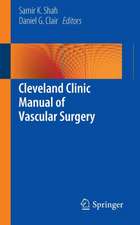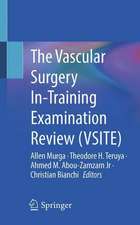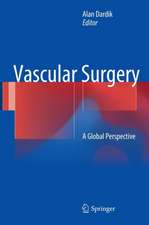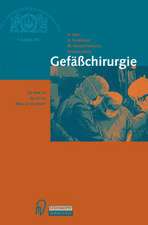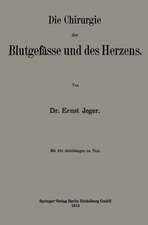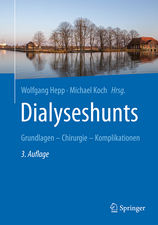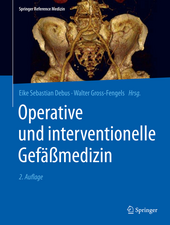Membrane Receptors, Channels and Transporters in Pulmonary Circulation: Advances in Experimental Medicine and Biology, cartea 661
Editat de Jason X. -J. Yuan, Jeremy P. T. Warden Limba Engleză Hardback – 10 mar 2010
| Toate formatele și edițiile | Preț | Express |
|---|---|---|
| Paperback (1) | 1583.98 lei 6-8 săpt. | |
| Humana Press Inc. – 26 noi 2014 | 1583.98 lei 6-8 săpt. | |
| Hardback (1) | 2091.12 lei 6-8 săpt. | |
| Humana Press Inc. – 10 mar 2010 | 2091.12 lei 6-8 săpt. |
Din seria Advances in Experimental Medicine and Biology
- 9%
 Preț: 719.56 lei
Preț: 719.56 lei - 5%
 Preț: 1095.03 lei
Preț: 1095.03 lei - 20%
 Preț: 691.93 lei
Preț: 691.93 lei - 5%
 Preț: 704.94 lei
Preț: 704.94 lei - 5%
 Preț: 704.94 lei
Preț: 704.94 lei - 5%
 Preț: 703.32 lei
Preț: 703.32 lei - 5%
 Preț: 704.22 lei
Preț: 704.22 lei - 5%
 Preț: 239.86 lei
Preț: 239.86 lei -
 Preț: 642.95 lei
Preț: 642.95 lei - 5%
 Preț: 820.42 lei
Preț: 820.42 lei - 5%
 Preț: 703.67 lei
Preț: 703.67 lei - 15%
 Preț: 629.45 lei
Preț: 629.45 lei - 15%
 Preț: 630.60 lei
Preț: 630.60 lei - 5%
 Preț: 1013.60 lei
Preț: 1013.60 lei - 5%
 Preț: 704.22 lei
Preț: 704.22 lei - 5%
 Preț: 705.14 lei
Preț: 705.14 lei - 20%
 Preț: 1142.10 lei
Preț: 1142.10 lei - 5%
 Preț: 1150.76 lei
Preț: 1150.76 lei - 18%
 Preț: 1100.97 lei
Preț: 1100.97 lei - 5%
 Preț: 1266.72 lei
Preț: 1266.72 lei - 5%
 Preț: 1145.01 lei
Preț: 1145.01 lei - 5%
 Preț: 1083.16 lei
Preț: 1083.16 lei - 18%
 Preț: 1104.69 lei
Preț: 1104.69 lei - 5%
 Preț: 1411.39 lei
Preț: 1411.39 lei - 20%
 Preț: 1026.46 lei
Preț: 1026.46 lei - 18%
 Preț: 930.42 lei
Preț: 930.42 lei - 5%
 Preț: 292.57 lei
Preț: 292.57 lei - 18%
 Preț: 941.47 lei
Preț: 941.47 lei - 18%
 Preț: 1214.88 lei
Preț: 1214.88 lei - 5%
 Preț: 1210.77 lei
Preț: 1210.77 lei - 5%
 Preț: 1270.49 lei
Preț: 1270.49 lei - 5%
 Preț: 1083.51 lei
Preț: 1083.51 lei - 18%
 Preț: 1113.70 lei
Preț: 1113.70 lei - 5%
 Preț: 1145.52 lei
Preț: 1145.52 lei - 5%
 Preț: 1394.53 lei
Preț: 1394.53 lei - 5%
 Preț: 1283.60 lei
Preț: 1283.60 lei - 18%
 Preț: 1393.77 lei
Preț: 1393.77 lei - 18%
 Preț: 1402.55 lei
Preț: 1402.55 lei - 24%
 Preț: 806.15 lei
Preț: 806.15 lei - 18%
 Preț: 1222.29 lei
Preț: 1222.29 lei - 5%
 Preț: 1405.29 lei
Preț: 1405.29 lei - 5%
 Preț: 1591.34 lei
Preț: 1591.34 lei - 5%
 Preț: 1283.09 lei
Preț: 1283.09 lei - 18%
 Preț: 1105.93 lei
Preț: 1105.93 lei - 5%
 Preț: 1079.03 lei
Preț: 1079.03 lei - 15%
 Preț: 638.91 lei
Preț: 638.91 lei - 5%
 Preț: 1079.03 lei
Preț: 1079.03 lei - 18%
 Preț: 929.84 lei
Preț: 929.84 lei
Preț: 2091.12 lei
Preț vechi: 2201.18 lei
-5% Nou
Puncte Express: 3137
Preț estimativ în valută:
400.32€ • 411.71$ • 332.11£
400.32€ • 411.71$ • 332.11£
Carte tipărită la comandă
Livrare economică 19 februarie-05 martie
Preluare comenzi: 021 569.72.76
Specificații
ISBN-13: 9781607614999
ISBN-10: 1607614995
Pagini: 966
Ilustrații: XVI, 501 p.
Dimensiuni: 155 x 235 x 28 mm
Greutate: 1 kg
Ediția:2010
Editura: Humana Press Inc.
Colecția Humana
Seria Advances in Experimental Medicine and Biology
Locul publicării:Totowa, NJ, United States
ISBN-10: 1607614995
Pagini: 966
Ilustrații: XVI, 501 p.
Dimensiuni: 155 x 235 x 28 mm
Greutate: 1 kg
Ediția:2010
Editura: Humana Press Inc.
Colecția Humana
Seria Advances in Experimental Medicine and Biology
Locul publicării:Totowa, NJ, United States
Public țintă
ResearchCuprins
Ion Channels in the Pulmonary Vasculature: Basics and New Findings.- The Role of Ion Channels in Hypoxic Pulmonary Vasoconstriction.- Two-Pore Domain K+ Channels and Their Role in Chemoreception.- Intricate Interaction Between Store-Operated Calcium Entry and Calcium-Activated Chloride Channels in Pulmonary Artery Smooth Muscle Cells.- The Role of Intracellular Ion Channels in Regulating Cytoplasmic Calcium in Pulmonary Arterial Smooth Muscle: Which Store and Where?.- Ca2+ Oscillations Regulate Contraction Of Intrapulmonary Smooth Muscle Cells.- TRP Channels in the Pulmonary Vasculature: Basics and New Findings.- to TRP Channels: Structure, Function, and Regulation.- Physiological Functions of Transient Receptor Potential Channels in Pulmonary Arterial Smooth Muscle Cells.- The Contribution of TRPC1 and STIM1 to Capacitative Ca2+ Entry in Pulmonary Artery.- Store-Operated Calcium Entry Channels in Pulmonary Endothelium: The Emerging Story of TRPCS and Orai1.- TRPM2 Channel Regulates Endothelial Barrier Function.- Pathogenic Role of Ion Channels in Pulmonary Vascular Disease.- A Proposed Mitochondrial–Metabolic Mechanism for Initiation and Maintenance of Pulmonary Arterial Hypertension in Fawn-Hooded Rats: The Warburg Model of Pulmonary Arterial Hypertension.- The Role of Classical Transient Receptor Potential Channels in the Regulation of Hypoxic Pulmonary Vasoconstriction.- Developmental Regulation of Oxygen Sensing and Ion Channels in the Pulmonary Vasculature.- Hypoxic Regulation of Ion Channels and Transporters in Pulmonary Vascular Smooth Muscle.- CLC-3 Chloride Channels in the Pulmonary Vasculature.- Receptors and Signaling Cascades in Pulmonary Arterial Hypertension.- Role of Bone Morphogenetic Protein Receptors in the Development of Pulmonary ArterialHypertension.- Cross Talk Between Smad, MAPK, and Actin in the Etiology of Pulmonary Arterial Hypertension.- Notch Signaling in Pulmonary Hypertension.- Rho Kinase-Mediated Vasoconstriction in Pulmonary Hypertension.- The Serotonin Hypothesis of Pulmonary Hypertension Revisited.- Impaired Vascular Endothelial Growth Factor Signaling in the Pathogenesis of Neonatal Pulmonary Vascular Disease.- Receptors and Transporters: Role in Cell Function and Hypoxic Pulmonary Vasoconstriction.- Mitochondrial Regulation of Oxygen Sensing.- Reactive Oxygen Species and RhoA Signaling in Vascular Smooth Muscle: Role in Chronic Hypoxia-Induced Pulmonary Hypertension.- Polyamine Regulatory Pathways as Pharmacologic Targets in Pulmonary Arterial Hypertension.- 5-HT Receptors and KV Channel Internalization.- Targeting Ion Channels and Membrane Receptors in Developing Novel Therapeutic Approaches for Pulmonary Vascular Disease.- KCNQ Potassium Channels: New Targets for Pulmonary Vasodilator Drugs?.- Receptor Tyrosine Kinase Inhibitors in Rodent Pulmonary Hypertension.- PDGF Receptor and its Antagonists: Role in Treatment of PAH.- PPAR? and the Pathobiology of Pulmonary Arterial Hypertension.- Targeting TASK-1 Channels as a Therapeutic Approach.- Pharmacological Targets for Pulmonary Vascular Disease: Vasodilation versus Anti-Remodelling.
Recenzii
From the reviews:
“The editors provide a good summary of the conference in this publication of the proceedings. … clearly intended for clinicians with a special interest in the field of pulmonary circulation. Researchers and basic physiologists will find the proceedings very useful for research technology and advancing their knowledge in the field. … Clinicians caring for patients with pulmonary hypertension will find this book very useful … . clinicians will find the book extremely helpful in understanding the pathophysiology of the disease they are treating.” (K. P. Ravikrishnan, Doody’s Review Service, May, 2010)
“The editors provide a good summary of the conference in this publication of the proceedings. … clearly intended for clinicians with a special interest in the field of pulmonary circulation. Researchers and basic physiologists will find the proceedings very useful for research technology and advancing their knowledge in the field. … Clinicians caring for patients with pulmonary hypertension will find this book very useful … . clinicians will find the book extremely helpful in understanding the pathophysiology of the disease they are treating.” (K. P. Ravikrishnan, Doody’s Review Service, May, 2010)
Textul de pe ultima copertă
Membrane Receptors, Channels and Transporters in Pulmonary Circulation is a proceeding of the 2008 Grover Conference (Lost Valley Ranch and Conference Center, Sedalia, Colorado; September 3-7, 2008), which provided a forum for experts in the fields of those receptors, channels and transporters that have been identified as playing key roles in the physiology and pathophysiology of the pulmonary circulation. The book rigorously addresses: i) recent advances in our knowledge of receptors, channels and transporters and their role in regulation of pulmonary vascular function; ii) how modulation of expression and function of receptors, channels and transporters and their interrelationships contribute to the pathogenesis of pulmonary vascular disease; and iii) the therapeutic opportunities that may be revealed by enhancing our understanding of this area. The overall goal was to explore the mechanisms by which specific receptors, channels and transporters contribute to pulmonary vascular function in both health and disease, and how this knowledge may lead to novel interventions in lung dysplasia, pulmonary edema, lung injury, and pulmonary and systemic hypertension to reduce and prevent death from lung disease. Membrane Receptors, Channels and Transporters in Pulmonary Circulation is divided into six parts. Part 1 (Ion Channels in the Pulmonary Vasculature: Basics and New Findings) is designated for basic knowledge and recent findings in the research field of ion channels in pulmonary circulation. There are five chapters in Part I discussing the function, expression, distribution and regulation of various ion channels present in pulmonary vascular smooth muscle cells and how these channels are integrated to regulate intracellular Ca2+ and cell functions. Part II (TRP Channels in the Pulmonary Vasculature: Basics and New Findings) is composed of five chapters that are exclusively designed to discuss the role of a recently identified family of cation channels, transientreceptor potential (TRP) channels, in the regulation of pulmonary vascular tone and arterial structure. Part III (Pathogenic Role of Ion Channels in Pulmonary Vascular Disease) includes four chapters that discuss how abnormal function and expression of various ion channels contribute to changes in cell functions and the development of pulmonary hypertension. Part IV (Receptors and Signaling Cascades in Pulmonary Arterial Hypertension) consists of five chapters devoted to the role of bone morphogenetic protein receptors, Notch receptors, serotonin receptors, Rho kinase and vascular endothelial growth factor receptors in the development of pulmonary arterial hypertension. Part V (Receptors and Transporters: Role in Cell Function and Hypoxic Pulmonary Vasoconstriction) includes four chapters designed to illustrate the potential mechanisms involved in oxygen sensing and hypoxia-induced pulmonary vasoconstriction and hypertension. Part VI (Targeting Ion Channels and Membrane Receptors in Developing Novel Therapeutic Approaches for Pulmonary Vascular Disease) consists five chapters which discuss the translational research involving on membrane receptors, channels and transporters, including their potential as novel drug targets. We hope that Membrane Receptors, Channels and Transporters in Pulmonary Circulation will allow readers to foster new concepts and new collaborations and cooperations among investigators so as to further understand the role of receptors, channels and transporters in lung pathophysiology. The ultimate goal is to identify new mechanisms of disease, as well as new therapeutic targets for pulmonary vascular diseases. An additional outcome should be enhanced understanding of the role of these entities in systemic vascular pathophysiology, since the conference will include researchers and clinicians with interests in both pulmonary and systemic circulations.
Caracteristici
Precise analysis of current research A collection of the lead researchers in the field Includes supplementary material: sn.pub/extras







